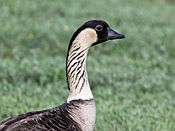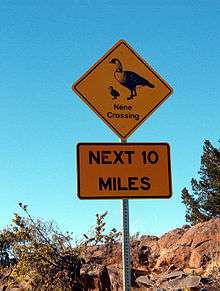Nene (bird)
| Nene | |
|---|---|
 | |
| At Kilauea Point National Wildlife Refuge, Hawaii, USA | |
| Scientific classification | |
| Kingdom: | Animalia |
| Phylum: | Chordata |
| Class: | Aves |
| Order: | Anseriformes |
| Family: | Anatidae |
| Subfamily: | Anserinae |
| Tribe: | Anserini |
| Genus: | Branta |
| Species: | B. sandvicensis |
| Binomial name | |
| Branta sandvicensis (Vigors, 1833) | |
The nene (Branta sandvicensis), also known as nēnē and Hawaiian goose, is a species of goose endemic to the Hawaiian Islands. The official bird of the state of Hawaiʻi, the nene is exclusively found in the wild on the islands of Oahu,[2] Maui, Kauaʻi, Molokai, and Hawaiʻi.
The Hawaiian name nēnē comes from its soft call.[3] The species name sandvicensis refers to the Sandwich Islands, an old name for the Hawaiian Islands.[4]
Evolution
It is thought that the nene evolved from the Canada goose (Branta canadensis), which most likely arrived on the Hawaiian islands about 500,000 years ago, shortly after the island of Hawaiʻi was formed. This ancestor is the progenitor of the nene as well as the prehistoric Giant Hawaiʻi goose[5] and nēnē-nui (Branta hylobadistes). The nēnē-nui was larger than the nene, varied from flightless to flighted depending on the individual, and inhabited the island of Maui. Similar fossil geese found on Oʻahu and Kauaʻi may be of the same species. The Giant Hawaiʻi goose was restricted to the island of Hawaiʻi and measured 1.2 m (3.9 ft) in length with a mass of 8.6 kg (19 lb), making it more than four times larger than the nene. It is believed that the herbivorous Giant Hawaiʻi goose occupied the same ecological niche as the goose-like ducks known as moa-nalo, which were not present on the Big Island.[6] Based on mitochondrial DNA found in fossils, all Hawaiian geese, living and dead, are closely related to the giant Canada goose (B. c. maxima) and dusky Canada goose (B. c. occidentalis).[5]
Description

The nene is a medium-sized goose at 41 cm (16 in) tall. Although they spend most of their time on the ground, they are capable of flight, with some individuals flying daily between nesting and feeding areas. Some are born without the ability to fly. Females have a mass of 1.525–2.56 kg (3.36–5.64 lb), while males average 1.695–3.05 kg (3.74–6.72 lb), 11% larger than females.[7] Adult males have a black head and hindneck, buff cheeks and heavily furrowed neck.[8] The neck has black and white diagonal stripes.[8] Aside from being smaller, the female nene is similar to the male in colouration. The adult's bill, legs and feet are black. It has soft feathers under its chin. Goslings resemble the male, but are a duller brown and with less demarcation between the colours of the head and neck, and striping and barring effects are much reduced. The bill, legs and feet are the same as for the adult.[8] Its strong toes are padded and have reduced webbing, an adaptation that allows it to swiftly traverse rough terrain such as lava plains.[9]
Habitat and range
The nene is an inhabitant of shrubland, grassland, coastal dunes, and lava plains, and related anthropogenic habitats such as pasture and golf courses from sea level to as much as 2,400 m (7,900 ft).[10] Some populations migrated between lowland breeding grounds and montane foraging areas.[9]
The nene could at one time be found on the islands of Hawaiʻi, Maui, Kahoʻolawe, Lānaʻi, Molokaʻi, and Kauaʻi. Today, its range is restricted to Hawaiʻi, Maui, Molokaʻi, and KauaʻI. A pair arrived at the James Campbell National Wildlife Refuge on Oʻahu in January 2014; two of their offspring survived and are seen regularly on the nearby golf courses at Turtle Bay Resort.
Breeding
The breeding season of the nene, from August to April, is longer than that of any other goose;[11] most eggs are laid between November and January.[7] Unlike most other waterfowl, the nene mates on land.[8] Nests are built by females on a site of their choosing, in which one to five eggs are laid (average is three on Maui and Hawaiʻi, four on Kauaʻi). Females incubate the eggs for 29 to 32 days, while the male acts as a sentry. Goslings are precocial, able to feed on their own; they remain with their parents until the following breeding season.[7]
Diet
The nene is a herbivore that will either graze or browse, depending on the availability of vegetation. Food items include the leaves, seeds, fruit, and flowers of grasses and shrubs.[10]
Conservation
The nene is the world's rarest goose.[12] It is believed that it was once common, with approximately 25,000 Hawaiian geese living in Hawaiʻi when Captain James Cook arrived in 1778.[8] Hunting and introduced predators, such as small Asian mongooses, pigs, and cats, reduced the population to 30 birds by 1952.[8] The species breeds well in captivity, and has been successfully re-introduced; in 2004, it was estimated that there were 800 birds in the wild, as well as 1,000 in wildfowl collections and zoos.[8] However, there is some concern of inbreeding due to the small initial population of birds. The nature reserve WWT Slimbridge, in England, was instrumental in the successful breeding of Hawaiian geese in captivity. Under the direction of conservationist Peter Scott, it was bred back from the brink of extinction during the 1950s for later re-introduction into the wild in Hawaiʻi. There are still Hawaiian geese at Slimbridge today. They can now be found in captivity in every WWT centre. Successful introductions include Haleakala and Piʻiholo ranches on Maui.[13][14] The nene population stands at 2,500 birds.
State bird
The nene is the state bird of Hawaii. It is also the rarest state bird.
Gallery
 Nene, Passerine Kauai, Princeville Ranch
Nene, Passerine Kauai, Princeville Ranch The distinctive neck pattern
The distinctive neck pattern Nene family
Nene family A group of Hawaiian geese; the bird on the right shows the characteristic foot
A group of Hawaiian geese; the bird on the right shows the characteristic foot A sign in Hawaiʻi warning of crossing Hawaiian geese
A sign in Hawaiʻi warning of crossing Hawaiian geese- Two Hawaiian geese at the Kīlauea Point National Wildlife Refuge.
 Group of Hawaiian geese on the golf course of Waikoloa in April 2010.
Group of Hawaiian geese on the golf course of Waikoloa in April 2010.
 At WWT Slimbridge in England
At WWT Slimbridge in England An illustration by Frederick William Frohawk
An illustration by Frederick William Frohawk Close up of head
Close up of head
References
- ↑ BirdLife International (2012). "Branta sandvicensis". IUCN Red List of Threatened Species. Version 2014.2. International Union for Conservation of Nature. Retrieved 29 November 2014.
- ↑ "Nene geese on Oahu for first time since 1700s". Hawaii News Now. 24 March 2014. Retrieved 25 March 2014.
- ↑ Pukui & Elbert (2003). "Lookup of nēnē". Ulukau, the Hawaiian Electronic Library. University of Hawaiʻi. Retrieved 13 January 2010.
- ↑ Jobling, James A. (1991). A Dictionary of Scientific Bird Names. OUP. ISBN 0 19 854634 3.
- 1 2 Harder, Ben (6 February 2002). "State Bird of Hawaii Unmasked as Canadian". National Geographic News. National Geographic Society. Retrieved 17 March 2009.
- ↑ Ziegler, Alan C. (2002). Hawaiian Natural History, Ecology, and Evolution. University of Hawaiʻi Press. p. 260. ISBN 978-0-8248-2190-6.
- 1 2 3 Reading, Richard P.; Miller, Brian (2000). Endangered animals: A Reference Guide to Conflicting Issues. Greenwood Publishing Group. pp. 142–146. ISBN 978-0-313-30816-1.
- 1 2 3 4 5 6 7 Ellis, Richard (2004). No Turning Back: The Life and Death of Animal Species. New York City: Harper Perennial. pp. 280–281. ISBN 0-06-055804-0.
- 1 2 Banko, Paul C.; Black, Jeffrey M.; Banko, Winston E. (1999). "Hawaiian Goose (Branta sandvicensis)". In A. Poole. Birds of North America Online. Cornell Laboratory of Ornithology. Retrieved 18 March 2009.
- 1 2 "Nene or Hawaiian Goose" (PDF). State of Hawaiʻi. 25 March 2005.
- ↑ "Hawaiian Goose (Branta sandvicensis)". Audubon Watchlist. National Audubon Society. Retrieved 18 March 2009.
- ↑ "Nene Pictures Showing this Highly Endangered Goose Endemic to the Hawaiian Islands". Marine Wildlife Photography.
- ↑ "Safe Harbor Agreement for the introduction of the nene to Piiholo Ranch, Maui" (PDF). State of Hawaii, Department of Land and Natural Resources. August 2004. Retrieved 13 January 2010.
- ↑ Standley, Bill (August 2004). "Ranchers Advance Recovery of Rare Hawaiian Bird". Environmental Defense Fund. Archived from the original on 24 January 2011. Retrieved 13 January 2010.
External links
| Wikimedia Commons has media related to Branta sandvicensis. |
| Wikispecies has information related to: Branta sandvicensis |
- BirdLife species factsheet for Branta sandvicensis
- "Hawaiian Goose media". Internet Bird Collection.
- "Branta sandvicensis". Avibase.

- Nene photo gallery at VIREO (Drexel University)
- Interactive range map of Branta sandvicensis at IUCN Red List maps
- Audio recordings of Nene on Xeno-canto.
